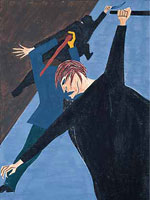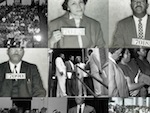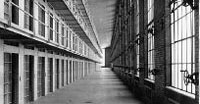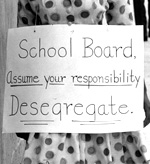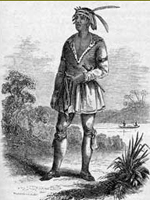Smithsonian American Art Museum: Close Observation
What can you learn from a source using just sharp eyes and an inquisitive mind? Suzannah Niepold of the Smithsonian American Art Museum guides teachers through close observation of four works of art, including Mike Wilkins's Preamble, Richard Norris Brooke's A Dog Swap, Allan Rohan Crite's School's Out, and Kerry James Marshall's SOB, SOB.
Suzannah Niepold: Just having lived in this country, you have all the background knowledge, all the tools you need, to analyze this and have some understanding of maybe what the artist is trying to say. It's a good starting point. I want you to use a really basic looking tool called the "Observation/Interpretation Chart," has anyone done anything like this before? Okay, yeah, it's pretty familiar. The goal is just to separate what you see from what you think it means. But it's more challenging for kids than you might think. Hopefully it will give them the tools they need to write a good historical argument, because you're essentially coming up with all your evidence, and then using that evidence to make an argument. So let's just start. Our goal is just to make a long list of observations based on this piece. What is it that you see here? Multiple Speakers: License plates. Suzannah Niepold: License plates. Okay, that's a— Speaker 1: State names. Speaker 2: Does spelling count? Speaker 3: Not for the HSA. Speaker 4: Somebody said state names. Speaker 5: ABC—yeah, alphabetical— Suzannah Niepold: Alphabetical order. The plates are in alphabetical order by. . .? Multiple Speakers: State. Speaker 2: Or district. Suzannah Niepold: There was some stuff over here I missed. Speaker 4: Common colors—white, blue, yellow, green. Speaker 5: It's "We the people of the. . . ." Suzannah Niepold: Ah, so it spells something out on the license plates. Speaker 1: It's the Preamble! Suzannah Niepold: The Preamble of the Constitution. Speaker 5: It's like each license plate has a state theme. Suzannah Niepold: How does it have a state theme? Speaker 5: On some of it. Like Alabama, "Heart of Dixie." Not all of them. Suzannah Niepold: Okay, so some of them have text— Suzannah Niepold: What else do you see on individual license plates? Speaker 6: A year. Speaker 5: Yeah, the year. And the artwork behind, depending on if it's just the plain—some are just two colors, some have three colors, some have like a picture behind it. Speaker 7: It's on the seat of a car, right? That somebody flattened out. Suzannah Niepold: Ah, so looking at the background reminds you of a seat of a car. Speaker 7: Like at a rest stop, or that you'd see in a diner or a drive-in or something. Suzannah Niepold: What do you see that makes you think diner or drive-in? What is it about the— Speaker 4: The metal on the outside of the cushiony seat. Speaker 5: And the color coordination. Suzannah Niepold: So the materials in the background make you think of the diner/drive-in or car seat. Speaker 8: How about six, five, six, six, five, six, five—in terms of how many license plates are in each row. Suzannah Niepold: So there's a pattern, there's not always the same number of license plates in a row, but it does alternate sort of sixes and fives. Speaker 2: Some have natural features on them while others are political statements. Suzannah Niepold: So the types of things chosen by the state, some are natural features and some are political. Speaker 5: It looks like some of them actually have—like Alabama has a tag on when they had to renew it and some don't, like if you look at Colorado, there's no dates on Colorado. Alabama's actually—it depends. And the number one color of the license plates—the background—tends to be white. The dominant color. Suzannah Niepold: That's good. A couple of people are noticing the dates on them, some of them have them, some of them don't, there's a bit of a range. Speaker 10: On most of the individual plates the words don't make sense by themselves. A couple do, like Hawaii is "none" and South Dakota is "this," but for the most part if you just look at one plate it doesn't really make much sense, it's just a couple of letters or numbers. Suzannah Niepold: So, looked at individually it's rare that a single license plate will have a word on it that makes sense. Is there anything else design-wise that is common to the license plates? Speaker 2: They're rectangles. Suzannah Niepold: So all the same shape. Speaker 3: They're bolted in with four bolts. Suzannah Niepold: Bolted in with four bolts, and those bolts are in the same location, right? Speaker 7: Deal with mass production for cars. Suzannah Niepold: There's evidence that these were mass-produced instead of custom made. Alright, are we ready to start moving into this column? Thinking about all of this as evidence, what do we think the artist is trying to say? Why did he put these license plates together to spell out the Preamble? And what does that tell us about our country? Speaker 2: Because all of them together is what shows us what our country is made of and really is the foundation of the nation, that we can't really go back to the Civil War era—we're not divided, we have to be all together. Suzannah Niepold: It's putting them all together is, how did you say, the spirit of the country? Speaker 2: Spirit of the country, basically what makes us make sense. Suzannah Niepold: So we are indivisible, we've come out of the Civil War and we're still part of the Union. Now what—: Speaker 4: It's obviously the shift to car culture, and that, you know, we are a nation of highways that are interconnected and the car is the way we get to places, we move from the cities to the suburbs, we move from Route 66. It's become—we're a nation of cars and highways. Suzannah Niepold: So his choice to use license plates is not random? Multiple Speakers: Right. Suzannah Niepold: He's really using that material to make another point about how we're a car culture. And that's another connection, right? As you mentioned, the highways connect all the states. Speaker 5: I also think it brings out the individual characteristics and history of each state, but yet we're all, as everyone has said, connected and that's what makes us strong. Yet, we each have flavor and things that are unique that make each state special. Suzannah Niepold: Great, so everyone had the theme or the slogan that you noticed, the symbols, whether they're natural environment or political symbols. The "flavor" is a great way to put it, but as he said, we're all indivisible; we're all part of the Union. I think maybe that pattern emphasizes that as well.
Suzannah Niepold: What's going on in this picture? Speaker 1: Relaxing after a hard day of work. Suzannah Niepold: What do you see that makes you say that? Speaker 1: You see both of the gentlemen sitting there who are sort of resting, as well as this younger gentleman over here. The little girl looks like she's kind of tired too. Speaker 2: The boots. Hanging. Suzannah Niepold: There are boots hanging here, okay. Speaker 3: He's got like work clothes on, and they look undone. Suzannah Niepold: Okay, so these look like his work clothes, how can you tell? Speaker 4: There are holes in them. Dirty shoes. Speaker 5: He's smoking a pipe. And the gun resting on the knee of the older gentleman. So maybe they were hunting? Speaker 6: They may be calloused, his hands [have] different coloration. So just outdoor work. Suzannah Niepold: So signs that they spend their time working outdoors. We noticed this man is smoking a pipe, this man is holding a gun. The pipe might add to the sense that they're relaxing after a hard day, and the gun might be an indication that they've been out hunting. Speaker 5: The black one looks like a hunting dog, the yellow one doesn't. Speaker 7: And there's another little one over underneath that the boy's playing with. Suzannah Niepold: This is one that's a little bit harder to see, especially if you're looking at this in reproduction, but there's a little tiny dog over here and then the two in the front. What makes this one look more like a hunting dog than the other two? Speaker 8: It looks like a Labrador. Suzannah Niepold: So it’s a breed we associate with hunting. Speaker 5: The yellow one looks like a herding dog. Suzannah Niepold: The title—which some of you might have noticed, we're not doing as much to cover it up this time—it's called A Dog Swap. What does that tell us about the picture? Speaker 7: So he's saying goodbye to his dog. Speaker 3: Or he's thinking about whether to go through with this or not. 'Cause he looks very pensive and the other guy looks like he's waiting for him to make up his mind. Speaker 8: He certainly has his gun there to make sure that he's— [laughter] Suzannah Niepold: You did something when you said waiting, you went forward a little bit, and I think that this man is leaning forward, which indicates that maybe he's waiting for an answer. As you said, this man is looking more pensive, more thoughtful. Speaker 1: Maybe that's why the little girl is sad? Maybe that's going to be her pet they're giving away. Speaker 5: Look at that little puppy, don't give him away! Speaker 1: They're going to give the black dog away because you can see he's kinda like comforting him, like don’t worry you'll be okay. Speaker 3: I think the little boy is interesting because he's kind of like fading into the background. Speaker 7: He's looking away. Suzannah Niepold: He's looking away, he's faded into the background a little bit. Why do you think the artist might have done that? Speaker 9: Maybe he's attached to the dog. Suzannah Niepold: Oh, he's attached to the dog. So why is he facing away? Speaker 9: It's his dog. Suzannah Niepold: Now what else is the little boy doing? Speaker 7: Playing with the other— Speaker 10: Focusing on a new dog. Suzannah Niepold: Yes, he's playing with this one. Speaker 10: Out with the— Speaker 9: Somebody's already said, we're getting a new dog. Suzannah Niepold: So he's coping with it by turning away, playing with the little puppy. Why do you think the choice of dog is important to this family? Speaker 7: It looks like they're in a field—so maybe, if the other dog is, like she said, a herding dog then it would be more working for them, for their livelihood, I guess. Speaker 10: Maybe this is a stretch, is that a fishing net? Suzannah Niepold: So they're using the land, they've got a fishing net. Speaker 8: You can see fencing in the background. Speaker 9: You've got your cabbage and collards up front. Speaker 7: One would assume that makes it a community kind of situation where people are helping each other; perhaps they are dependent on each other. Hunter-man brings meat, and this family farms. Suzannah Niepold: Okay, so maybe it's a community exchange. Speaker 3: Some kind of sharecropping. Suzannah Niepold: What else can you tell about their daily life and the condition of their home? Speaker 1: A dirt entryway. Speaker 7: You can tell in terms of relationships, Mom's in the doorway kind of hovering in the back with what looks to be the older daughter. So the women are kind of back away from the decision making of this or in the home, so to speak. Suzannah Niepold: So the decisions are being made by the men, the women are a bit farther away. Speaker 7: Yeah, because even the boy is outside. Suzannah Niepold: Someone mentioned sharecropping, this painting is from 1881, the artist is from Warrington, VA, so not too far away. So if this is painted after the Civil War, a little bit even after Reconstruction, what do we know about the lives of these people? Speaker 8: They're very, very tough. Suzannah Niepold: Tough how? Speaker 8: They're having to make their own way in a segregated society where nobody's looking out for them. And sharecropping—very tough, very tough occupation. Suzannah Niepold: Tough life. As you noticed in the beginning, probably working outside, working the land, getting food however they can—whether it's growing things, fishing, hunting. What are maybe some of the advantages though? Multiple Speakers: Free; self-sufficient; freedom Suzannah Niepold: Self-sufficiency, freedom. Speaker 9: Autonomy. Suzannah Niepold: Autonomy. Speaker 7: You have the ability to build relationships, remember we were talking about the community. Before you could be sold off and not have a family and not be a part of a family. Speaker 3: And they're trading property that they have now, which before they would not have been able to. Suzannah Niepold: So they have property. So the dogs maybe represent that. Someone mentioned family; I think that's very important that you have a family group together.
Suzannah Niepold: This is a work that I find really interesting because even though it's really an everyday scene there's a lot of maybe kind of misconceptions that feed our interpretation of this work. So I'm interested to see what you can make of it. What's going on in this picture? Speaker 1: There are no men. Suzannah Niepold: There are no men, so it's all women. And what else? Speaker 2: These little girls are fighting. Suzannah Niepold: How can you tell that they're fighting? Speaker 2: Because the one girl is yelling at her, wearing red, and the little girl in blue has her hands at her hips and is like nyah-nyah-nyah-nyah. So, you can tell they're fighting. Suzannah Niepold: So the artist gives us some really clear body language. The girl in the red top sort of leaning forward, mouth wide open, the other girls have kind of squinchy faces. Speaker 3: It seems like school, like parents dropping their kids off or picking their kids up or something. Speaker 4: The moms don't look real happy. Suzannah Niepold: So there's not any sort of bright smiles on any of the women's faces. How about the scene as a whole, what do you think the mood of the whole picture is? Speaker 1: Well, could it be Sunday? Speaker 6: Yeah, I'm thinking it could be Sunday. Because the mother has a flower on her lapel. It could be Sunday. Suzannah Niepold: Without looking at the title, which is going to give it away, how can we tell if it’s a school-related thing, as you first thought, or a Sunday, like church perhaps. Speaker 6: There's no religious imagery in it. Speaker 3: A couple of them have books, but the books are different colors, and they don't say Bible. There's nothing that looks churchy, there are no crosses. Speaker 1: There's nobody wearing hats, that's churchy. Speaker 5: None of them are wearing hats. Speaker 2: Not all of them. Speaker 3: There's one woman in a hat. Speaker 7: Is that a graduation hat? Suzannah Niepold: You know, that's one of the misconceptions again because it has that kind of flat top. But if you look at it closely it's not a mortarboard, it’s a fancy hat. Speaker 7: They're all wearing dresses. Speaker 8: I was thinking '50s. Speaker 5: Girls didn't wear pants back then. Speaker 6: If it's Sunday, where are there husbands and sons and brothers? Speaker 5: It could be a Women's Day; I've gone to Women's Day events before. So it could be Women's Day. Suzannah Niepold: Someone mentioned there are no churches in the background, can you identify any types of buildings in the background? Speaker 5: I don't know—it looks like a school. Suzannah Niepold: But which part looks like a school and how can you tell? Speaker 7: The left. Speaker 5: But a lot of churches are in schools. I went to church in a storefront, so—back then, I don't see a storefront, but I used to go to church here in Maryland in a school. I think it's probably a school or a church event. So it doesn't necessarily have to be "school" because people don't always go—in urban settings, people don't always have access to a church building. They do church in different buildings. Speaker 2: I think their skirts are too short for church. Speaker 9: That's what I was thinking, that one girl kneeling— Suzannah Niepold: Some of the evidence I hear for school is that this fence was built maybe to control people, to keep them in, so maybe the playground is inside the fence. As you said, there's no men, it's all women and female children. The clothing will throw your students off, they're not used to an everyday scene where everyone is in dresses or everyone is dressed up. What else is going on, what else can you find? Speaker 4: It reminds me of Baltimore with the red brick and the stoops and the Federalist architecture. Speaker 6: The obvious thing to me is that there's black and white children and that right central there's an African American woman holding the hand of an African American child and what appears to be a white child has her arm wrapped around that woman. Speaker 3: It seems the African American women are the ones caring for the kids. And maybe the mom's coming to get her? Speaker 5: But they're not wearing maid uniforms. Suzannah Niepold: So the adults, unless I'm getting this wrong, are all African American—or the ones that I can see. Speaker 2: No. Speaker 4: She's raising her hand. Suzannah Niepold: But there are children, there are Caucasian children. Speaker 5: Well, wouldn't the Caucasian children be with their nannies? Speaker 9: That's what I was wondering, are they nannies? Suzannah Niepold: Are they nannies, or what other roles could they be filling? If it's a school scene— Multiple Speakers: Teachers. Suzannah Niepold: If this is a school, what do we know about the school based on the people that we see. Speaker 5: All girls. Speaker 6: It's mixed. Suzannah Niepold: It's mixed, it's not segregated by race, just by gender. Speaker 5: I don't know, African American people are all different colors, so when I see someone who's lighter I don't assume they're white. Suzannah Niepold: That's true, sometimes you can get into dangerous— Speaker 5: I'm not saying they are or aren't at this point, I'm not saying that. Suzannah Niepold: You're right, so we can leave it as an open question mark. But there are certainly children with—just literally white, not even peach-colored. Speaker 6: Right, because that girl with her hand up stands out to me in the back. She's like waving; I can't tell what she's doing. Speaker 7: It's almost designed to draw your attention. Suzannah Niepold: The title is School's Out, so whoever said end of the daym whoever said school, they're borne out by the title. It's 1936. What part of the country would we imagine this to be? You said it looks a little like Baltimore. Speaker 10: Gotta be in the North. Suzannah Niepold: Okay, why does it have to be in the North? Speaker 10: Because of the integrated school. Suzannah Niepold: And why does it have to be a big city? How can we tell that about the image? Speaker 4: Because of the Federalist architecture. Speaker 6: And that's a lot of people. You wouldn't have that many children of that age in a small town school. Suzannah Niepold: This artist—one of the reasons that we always put the birth and the death dates and locations of the artist is to try and give you a sense of where the scene might be and what their background knowledge is. Allan Rohan Crite spent most of his life in Boston. So we think, based on an interview with him, that this is a South Boston school in 1936. If you look at the history of segregation in the schools—because he is an African American artist, this is an African American show—is that the schools were desegregated in the 19th century, but the neighborhoods weren't. So because the schools were just organized by neighborhood they were still vastly majority African American school or white school. So here you see maybe a few who either are light-skinned or are white, but certainly the majority are African American.
Suzannah Niepold: So again, just take a minute to observe the detail before we talk about it. What's going on in this artwork? Speaker 1: It's looking kind of at a study of Africa, of African culture. Suzannah Niepold: What do you see that makes you say that? Speaker 1: The books that I can see from here are about—you've got Africa and Asia, The Soul of Africa, the book there Africa Since 1413. Suzannah Niepold: So the book titles are turning into a bit of a clue about the artist's intention or message for the entire work. And something that really pops out to you is Africa. Speaker 2: Americans in particular like W.E.B Du Bois and the language that of course then was used, so you certainly see like the African American experience. Suzannah Niepold: It's an African American experience but tied back to Africa, which is appropriate since we are in the American Art Museum. Speaker 1: Then you have some odd ones that seem out of place, like Pushkin. Speaker 3: And some of covers seem more worn than others. Suzannah Niepold: Some of the books are maybe more worn, more well read than others. Are there any in particular that look more worn? Speaker 3: The Du Bois book. Suzannah Niepold: Because the title is wearing off a little bit. Speaker 4: She has then N and the A Encyclopedias of Knowledge, Culture, and I don't know what that word is on the bottom shelf. Suzannah Niepold: Yeah, it doesn’t always give you the title. So there's a repeated theme in the encyclopedias, that the volumes on the shelf refer to the N words or the A words. Speaker 1: Well the n-word is right there. Suzannah Niepold: Yes. And that is an issue, obviously, if you're using this in schools, and if you want to talk about that we certainly can. I use it only on a kind of case-by-case basis depending on the teacher and the class in school. But this can be kind of a major point of discussion with kids, the language that's used in the text. What more can you find? Speaker 5: I think I'm in debate on "sob," if it's really "sob" or if it's son of a— Suzannah Niepold: So there are these words here that could be read as "sob" or could be read as "S.O.B." Again, with prior approval from the teacher I have taught that acronym to about 300 8th-graders at this point. Doing well! What else do you notice about the words, how are they painted? What are they? Speaker 4: Her thoughts. Suzannah Niepold: Her thoughts. Where do we recognize that as thoughts from? Where do we get that? Multiple Speakers: Comics. Suzannah Niepold: Cartoons, comic books, so that's one kind of influence on this artwork. What more can you find? Speaker 6: She seems to be looking out somewhere. We see this window here, I don't know if she's looking at someone or out the window. Suzannah Niepold: How can you tell where she's looking? Speaker 6: Well, I mean just from the way her face is turned, her eyes are directed someplace other than— Suzannah Niepold: Everything—her face and her eyes are directed up here and directed away from the books. Speaker 7: I don't think it's her house. Suzannah Niepold: Okay, tell me what do you see that makes you say that? Speaker 7: I just look at how she's dressed, she's got on heeled shoes, she might—from where I'm thinking—just be visiting and all of a sudden inspecting somebody else's library. And then she just starts pulling off these books, and then she turns and maybe she just has a question or a strong feeling. Suzannah Niepold: Ah, strong feeling. Well, we see her thoughts. Speaker 4: So she may be listening to someone and thinking. And then she's also sitting on the floor, you're right, she's dressed up, but she's sitting on the floor. Speaker 3: What about those two books on the second shelf? The Slavery of Freedom and Black Women and White America almost as like questioning of the future, what's been lost? Speaker 8: I see bookshelves like this every ay at the office because you're always trying to figure out who the occupant is based on what they're reading. One of the things that kind of connects the books for me is this idea that Africa is interesting and significant as long as it's impacting white people. Africa becomes interesting when we start exporting slaves, Slavery to Freedomm you know it's the ownership of African Americans that makes it important. It's not interesting in and of itself, but only in its implications. Which would make me say either "sob" or "S.O.B." Suzannah Niepold: Yes. That's interesting, first of all because by looking at a bookshelf we can tell a lot about the identity of the owner of the bookshelf, who has arranged or even curated that collection of books. And also that so many of these are focused on Africa after European contact and the impact on this country. All of these books, I don't know if you've ever read any of them, but they are all real. We did end up featuring this in one of our programs I work on with 8th-grade students because the teacher, when selecting works with me, came up and said my parents had the same bookshelf. Not literally the same bookshelf, this very kind of fragile—maybe it's meaningful that the artist put this one spindly leg out there so that the whole history is going to just crash down. But she really related to this and she wanted to kind of bring some ideas together in her classroom and she was comfortable bringing out some of the more uncomfortable history, which, depending on your class and your group and how well you know them, you may not be. So this is one of the more challenging works, but the result, the product we got, we had students write about this work, were in the end deeply meaningful and they found real relevance to their own histories here. So we found it worth it in that situation.
